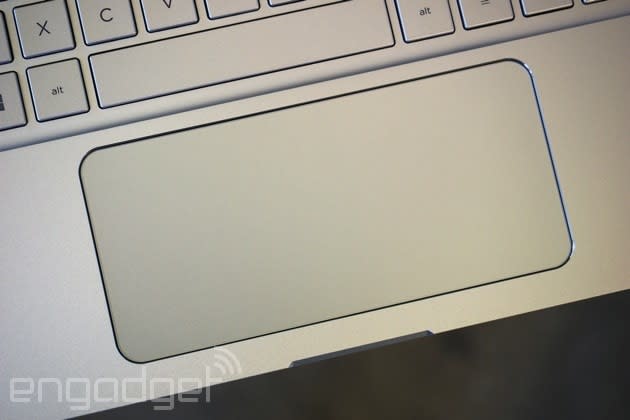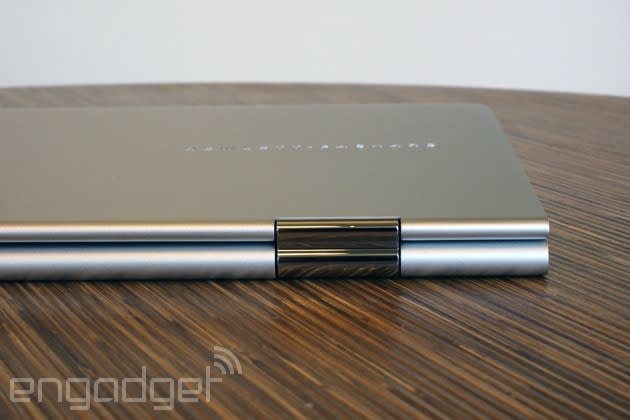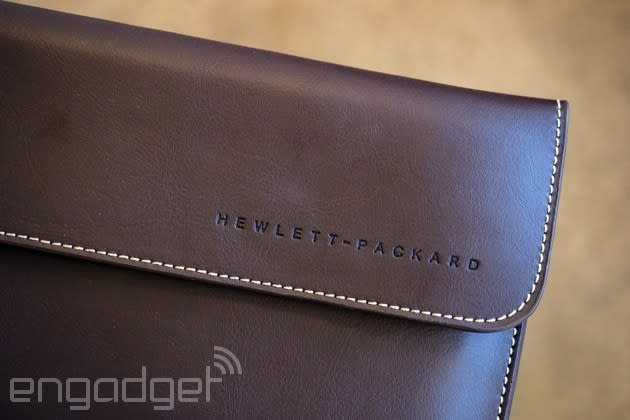HP teamed up with Microsoft to build its latest flagship laptop

This isn't your typical laptop announcement post. The most interesting thing about the Spectre x360, HP's new flagship notebook, isn't its design, performance or even price. No, what's interesting about this laptop is that Microsoft helped build it. Over the course of a year and a half, the two companies met regularly to hash out everything from the BIOS, fan noise and wireless range, even obsessing over details like the screen's color gamut. The result is a well-built laptop that promises long battery life, fast performance and one clean OS install. If you've ever speculated about whether Microsoft might make its own clamshell notebook, this is probably the closest you're going to get. HP of course deserves much of the credit, but make no mistake: The x360 has Redmond's stamp of approval all over it.
Actually, there's another company that deserves some credit: Lenovo. The x360 has the same general design popularized by Lenovo's Yoga series, complete with a 360-degree hinge that allows the laptop to fold back into tablet mode, as well as "Stand" and "Tent" positions. (HP isn't even shy about using those names for its usage modes; those, too, were first used by Lenovo.) Once you accept that this isn't a groundbreaking machine, though, it's easy to appreciate how well-built it is. The x360 is cut from CNC-machined aluminum, with no visible seams and a sturdy chassis that doesn't bend under pressure. Also, unlike Lenovo, HP figured out how to design a 360-degree hinge that somehow folds into itself -- meaning the laptop is equally thick whether it's in tablet or regular notebook mode. Finally, HP endowed the machine with a healthy selection of ports, including HDMI, a Mini DisplayPort and three USB 3.0 sockets. All that's missing is an Ethernet jack, but lucky for you, HP includes an adapter in the box (plus a VGA dongle, if you're old-school). (Update: The adapters are sold separately; HP just included them gratis for us reviewers.)

The centerpiece of all this is a beautiful 13.3-inch, optically bonded IPS display. Depending on the configuration, the resolution is either full or Quad HD (1,920 x 1,080 or 2,560 x 1,440), but regardless, the screen has a 72 percent color gamut. Unsurprisingly, then, the colors are nice and rich, without being overly saturated, though the touchscreen's glossy finish might cause problems for people who like to work outside, or near open windows. As for the keyboard, it's early days yet for me, but so far, I'm enjoying the well-spaced, cushy keys, which offer 1.5mm of travel. Which makes sense: At 15.9mm (0.63 inch) thick, the x360 is slightly thick for a 13-inch laptop, even one with a 360-degree hinge, so it makes sense that there'd be room for a springier set of keys. Oddly, HP didn't seem to collaborate much with Microsoft on the trackpad. That's not to say that Microsoft didn't have a chance to provide feedback, but what's odd here is that this isn't a Microsoft-made Precision Touchpad. Instead, it's a Synaptics touch surface -- the same sort of extra-wide one used on HP's last-generation flagship, the Spectre 13.

As you can see, then, I'm generally taken with the x360, though it feels surprisingly heavy for a 13-inch laptop, especially one being touted for its portability. All told, it weighs as little as 3.17 pounds, depending on the screen resolution. (The entry-level configuration weighs 3.26 pounds with a 1080p display; the higher-end Quad HD model uses a thinner panel.) It's not a back-breaker, of course, but it's definitely denser than other 13-inch systems. Lenovo, for instance, recently unveiled a laptop with a similar 360-degree hinge that weighs just two pounds. HP says it was shooting for less than four pounds here, but at this point, sub-three should really be the new benchmark.
If there's an upside to a slightly heavier machine, it's that the battery life is said to best most of its competitors. HP rates it for up to 12.5 hours, largely thanks to a 56Wh battery -- an unusually high capacity for a machine this size. In addition, though, HP and Microsoft were especially perfectionistic about battery life, choosing not just a large cell, but also poring over the system settings, looking for possible waste. Together, they decided to shut down certain parts of the system when not in use, including the sensors in the hinge that tell the x360 what mode it's in. They also settled on what they describe as low fan noise, in part to conserve juice. Meanwhile, the Quad HD panel uses PSR (Panel Self Refresh) technology, which avoids changing pixels unnecessarily to reduce power consumption. I'm in the middle of testing the x360, and will run several battery tests before publishing my review.

The two companies also teamed up to test the machine's WiFi performance. In the end, HP went with a 2x2 802.11ac wireless radio, with the antenna housed inside a slot opening at the top of the lid. According to HP and Microsoft, the x360 doesn't drop off in speed as quickly as similarly equipped machines, and that goes for both the 2.4GHz and 5GHz bands. I'll also be testing that in my eventual review, though I suspect my verdict will generally amount to something a little less specific, like "fast."
Finally, there's the question of software -- and it's a big one, considering Microsoft was involved. As you'd expect, the Windows team didn't let HP get away with preloading tons of crapware. In fact, HP Technical Marketing Manager Kevin Wentzel said this is "one of the cleanest images HP has ever produced." To be clear, it's not entirely free of bloatware, but it's close: My test machine came with Netflix and The Weather Channel, as well as Hearts Deluxe and a few of HP's own apps, like Connected Photo. So, not a Microsoft Signature Series machine, exactly, but it's a step in the right direction.
Also as you'd expect, Microsoft worked with HP to optimize the machine to run Windows itself. Specifically, Windows 8, which is what the machine will initially ship with. Unsurprisingly, though, execs from the two companies shied away from talking much about Windows 10, which is still in development, but comments from both camps suggested that once the x360 went on sale, they'd be shifting their engineering resources to focus more on Win 10. Certainly, I hope the x360 will be just as fine-tuned for Microsoft's next-gen operating system as its current one.

The x360 is available now, and will start showing up in Best Buy stores later this month. The entry-level configuration starts at $900 -- not bad for a machine of this caliber -- with a fifth-generation Intel Core i5 processor, 4GB of RAM, full HD display and a 128GB solid-state drive (SATA, we're told -- not PCIe). There's also a $1,150 model with a Core i7 CPU, 256GB drive, 8GB of RAM and a full HD display. To get that Quad HD panel, you'll need to pay $1,400, at which point you also step up to 512GB of solid-state storage. Additionally, HP is selling an optional leather sleeve (I've included a couple shots in my hands-on gallery), along with an "active pen," though it's worth noting there isn't actually a digitizer built into the touchscreen itself. In any case, as you're all aware by now, I'll be reviewing this over the coming days and will follow up soon with a full review. Until then, happy "new phones and tablets" week!
Don't miss out on all the latest news, photos and liveblogs from MWC 2015. Follow along at our events page.









































